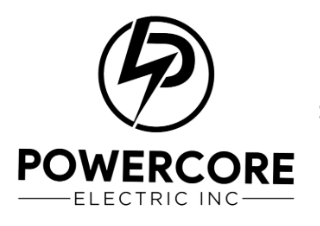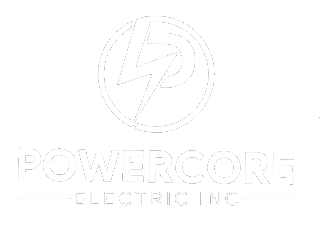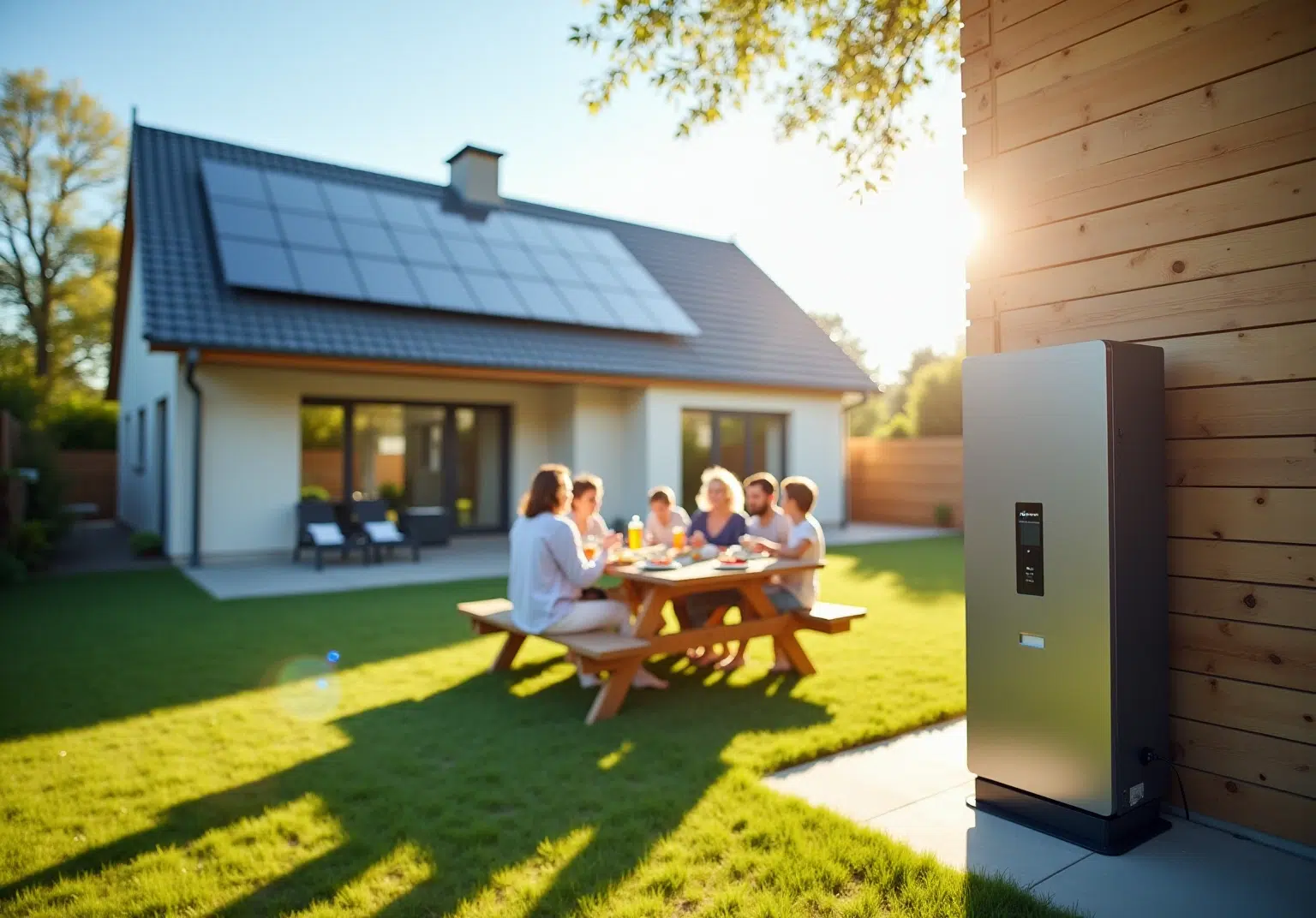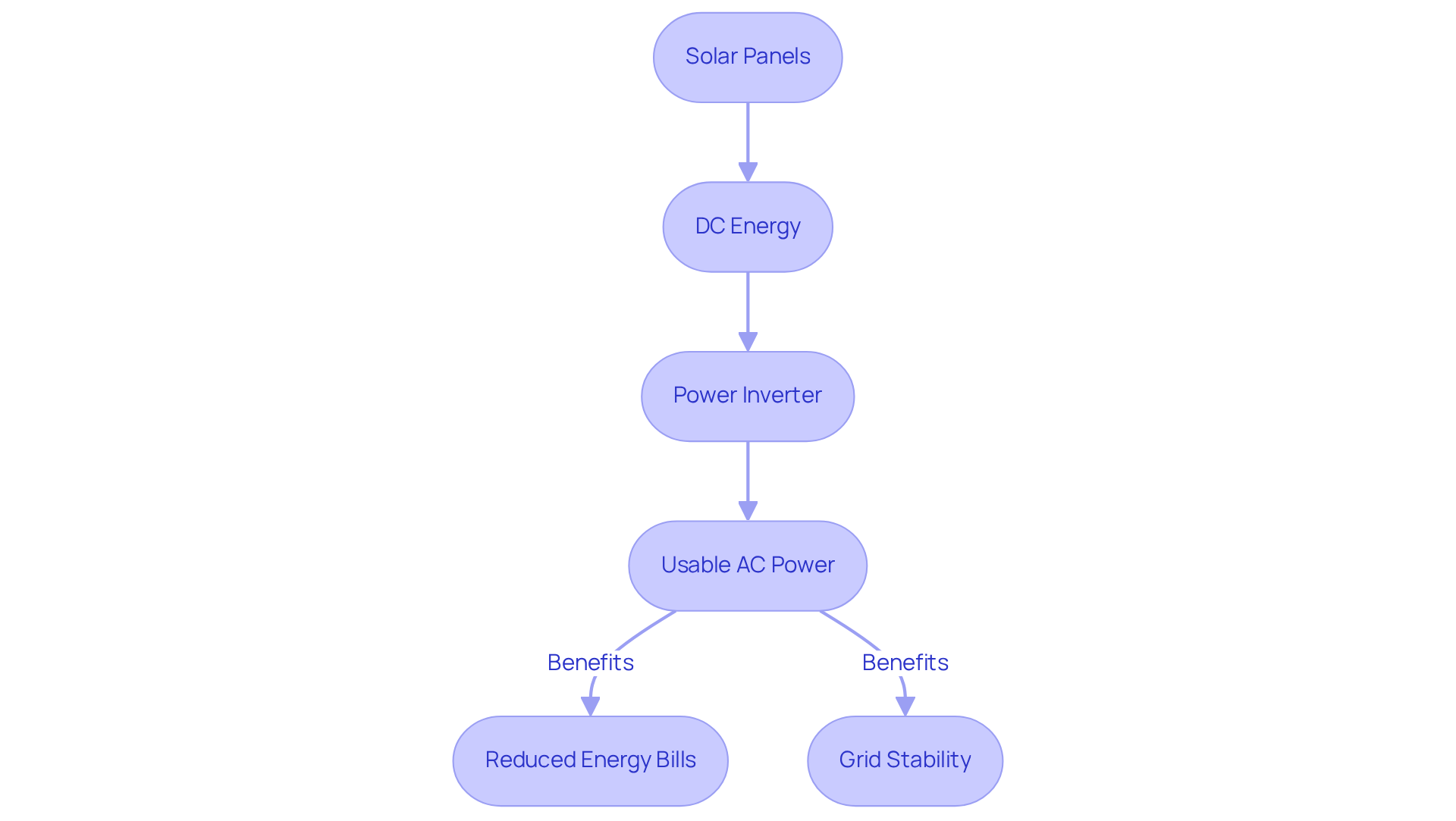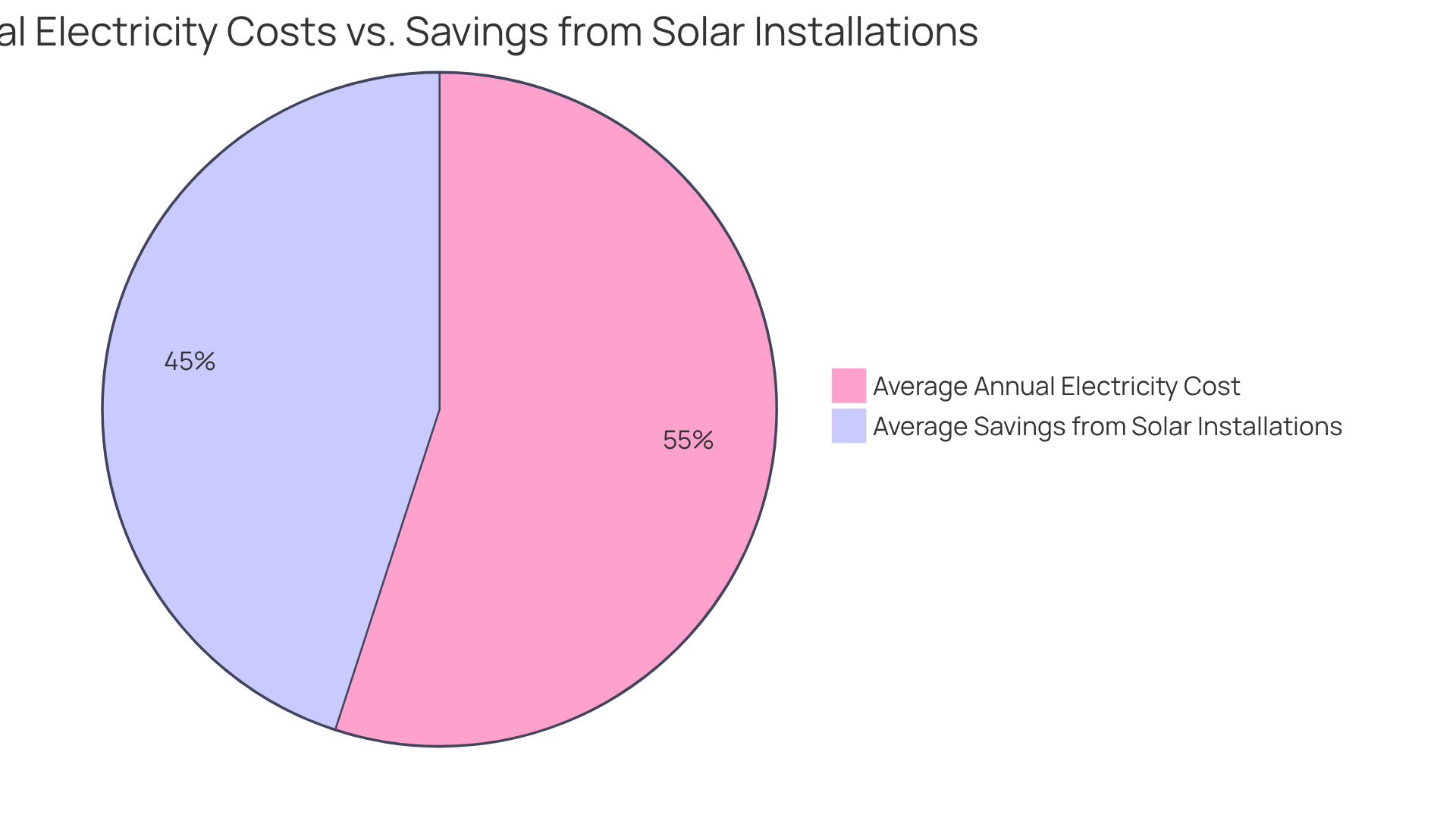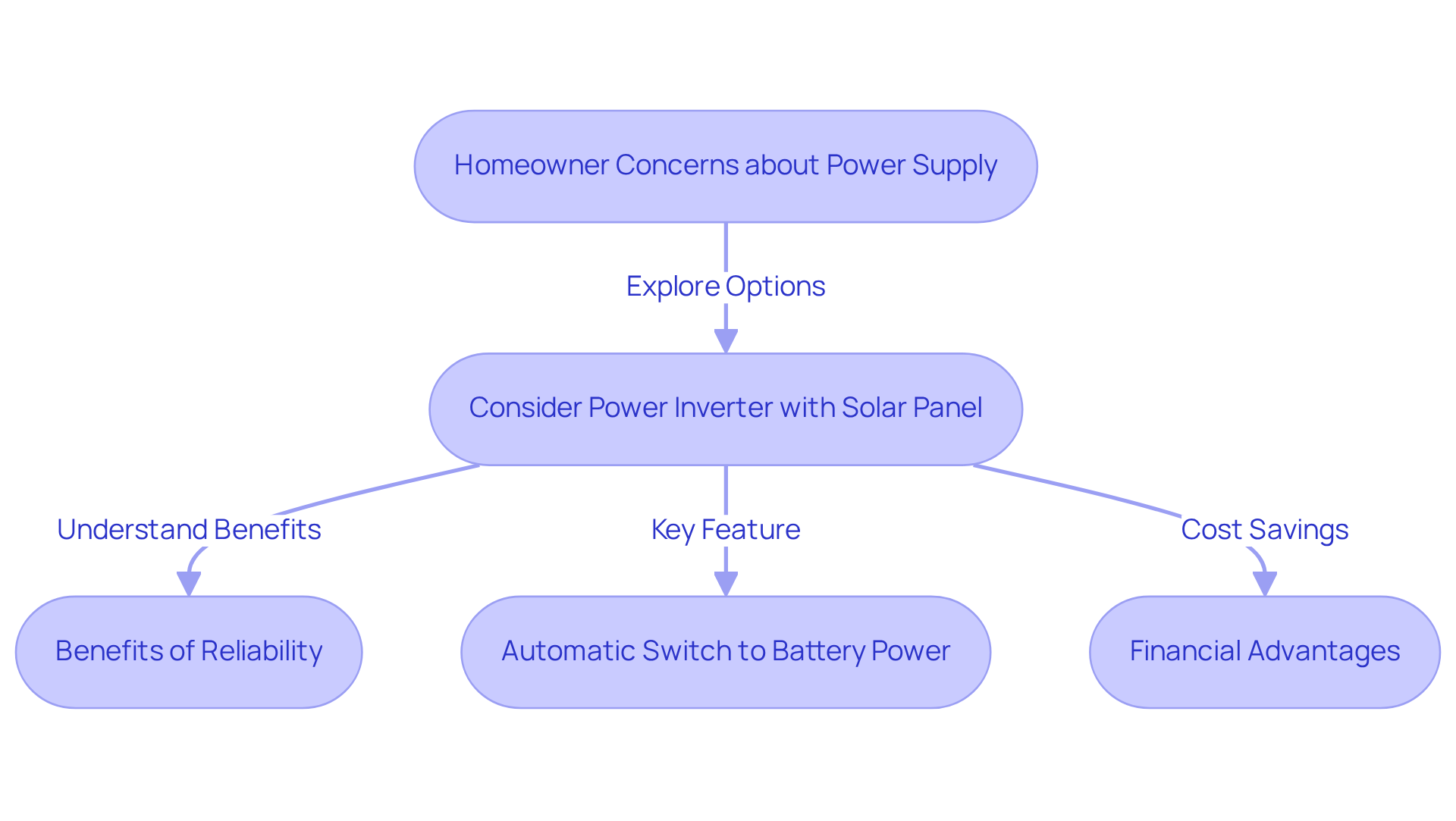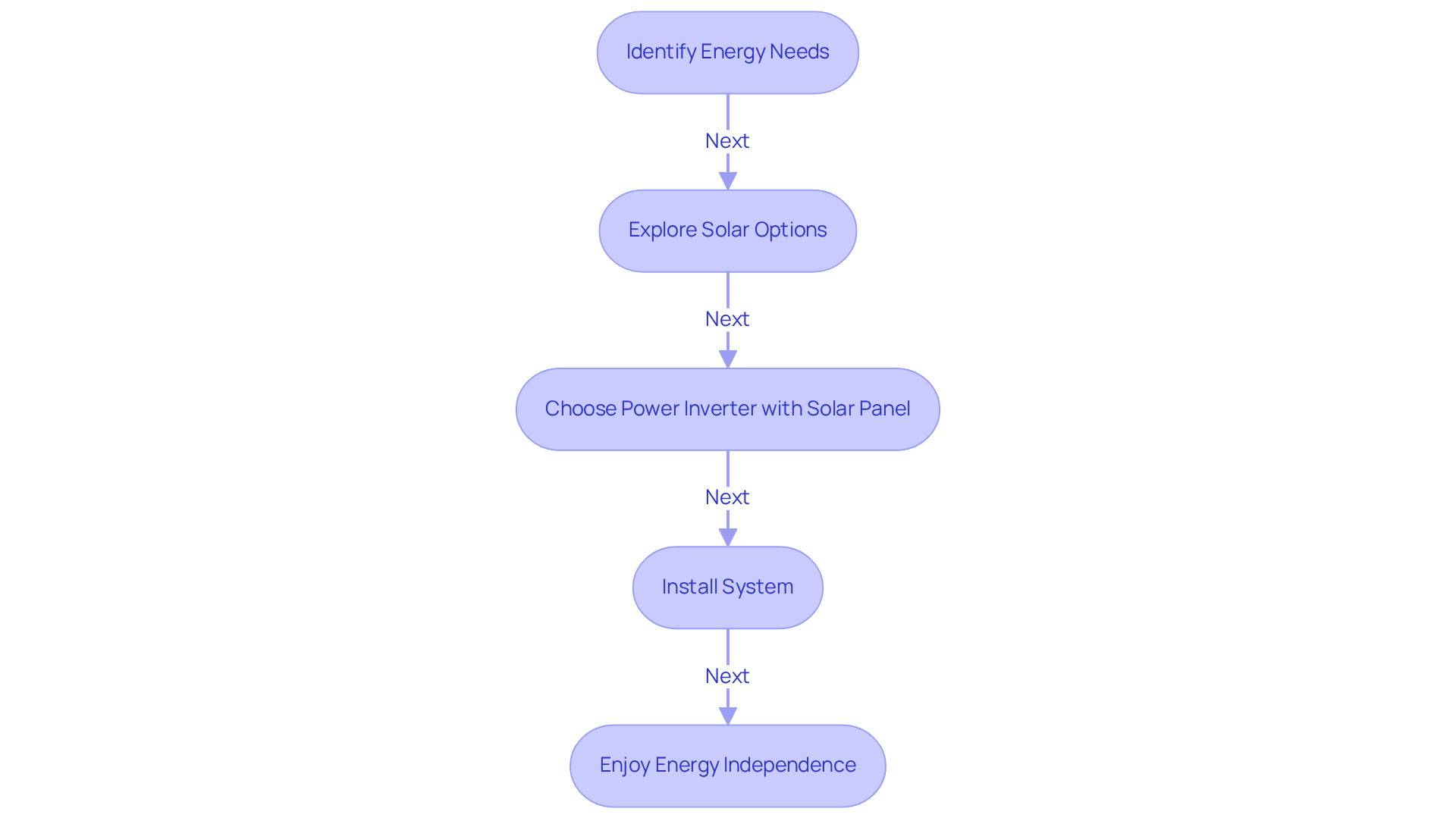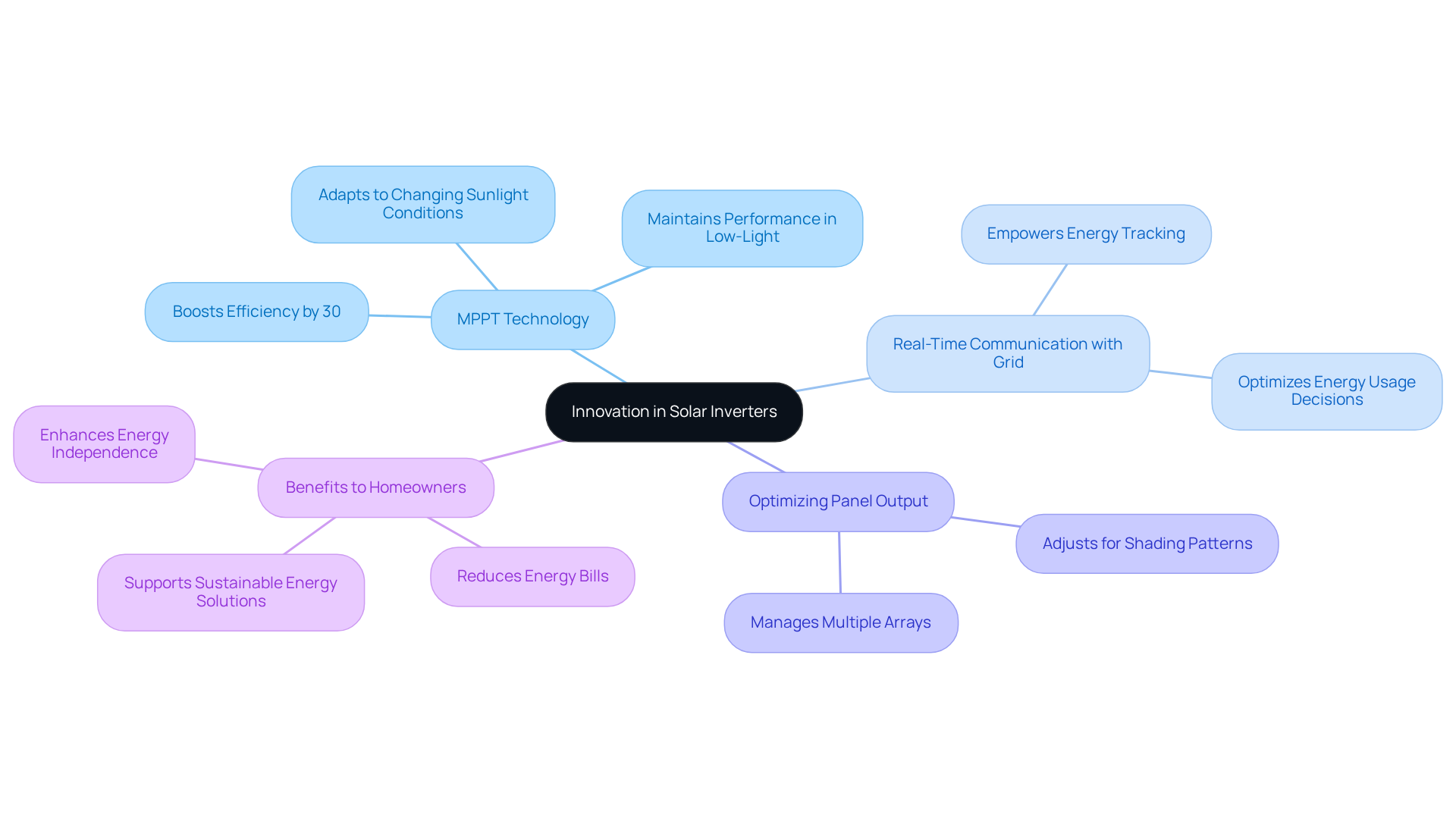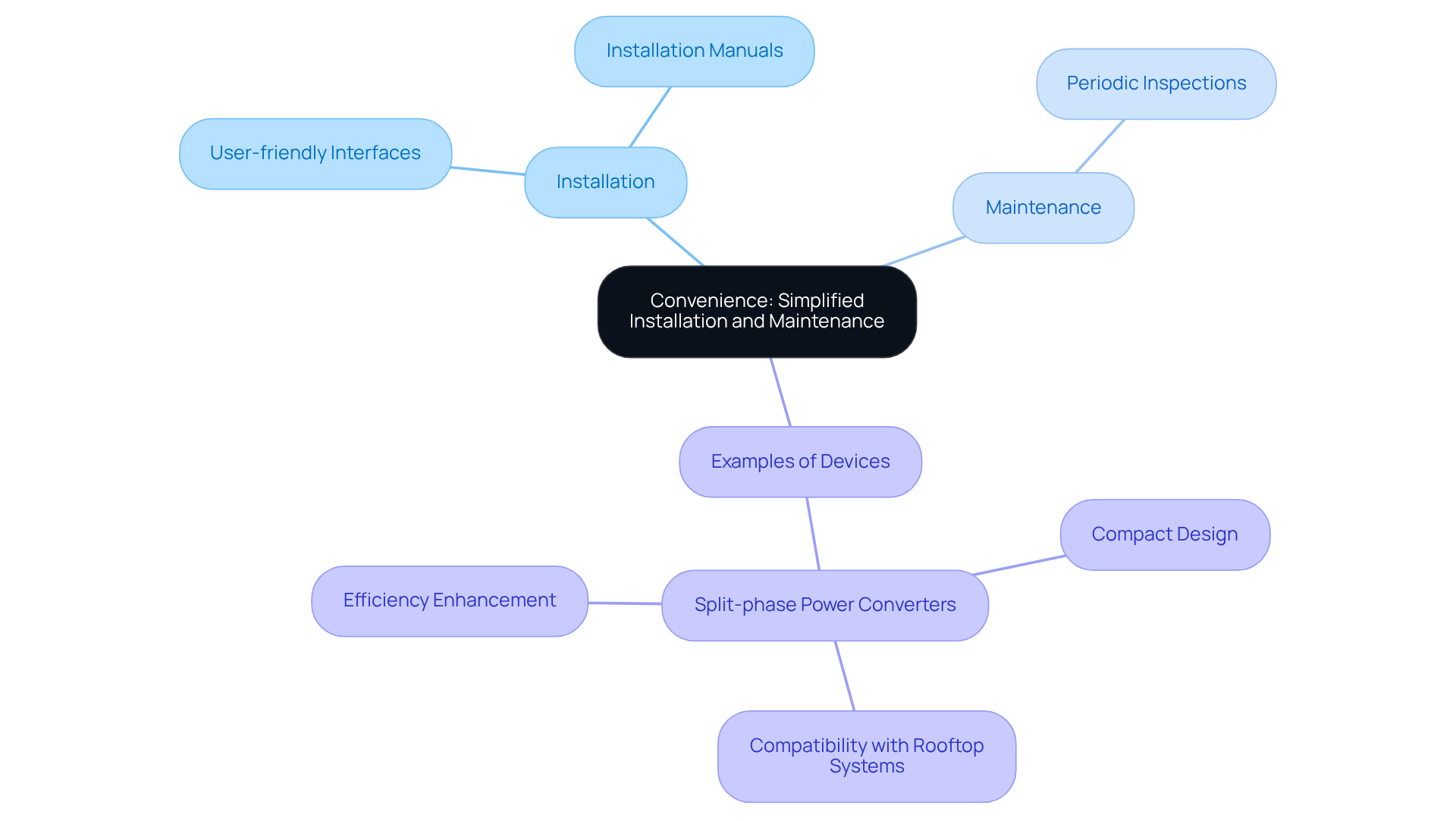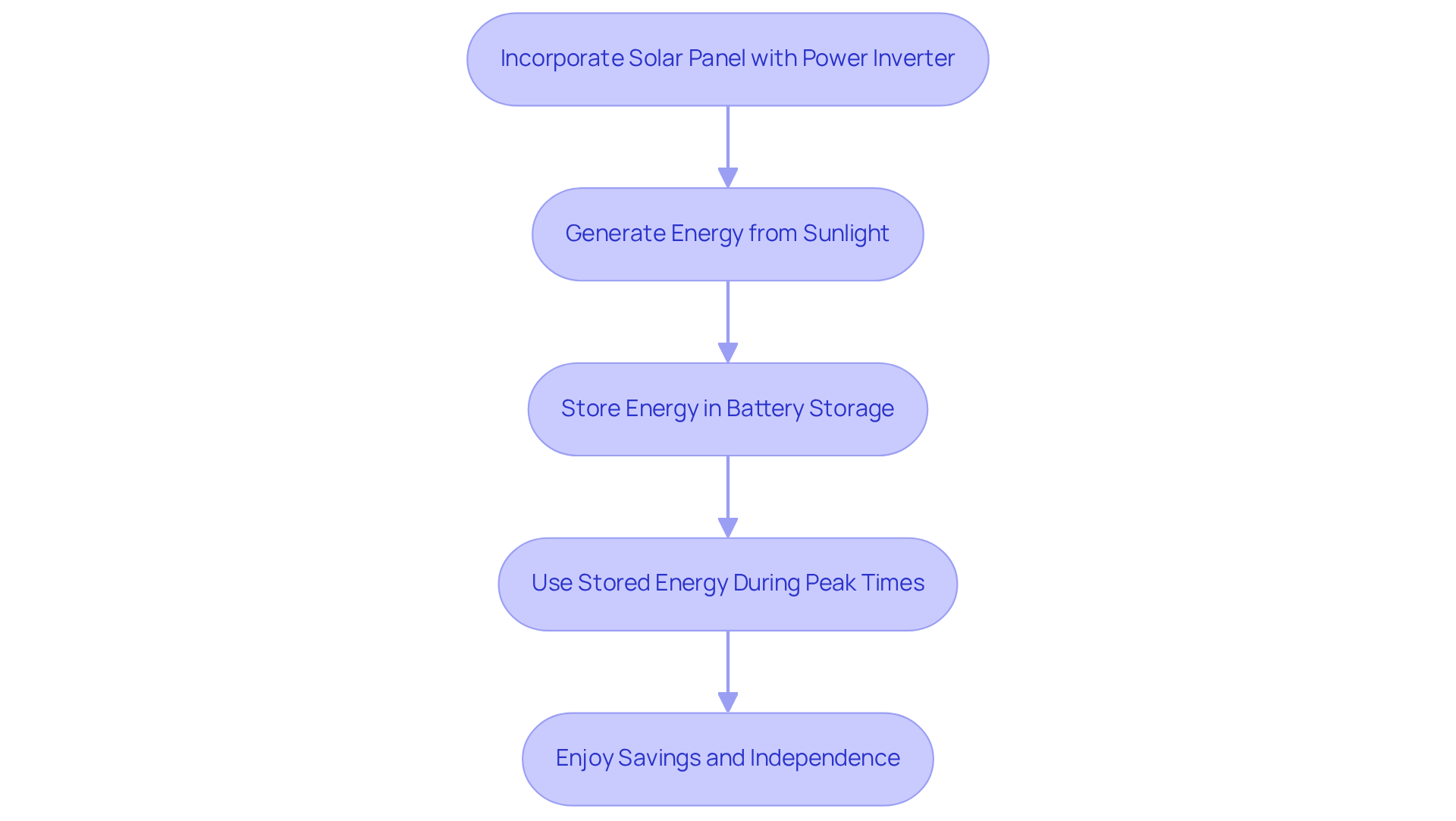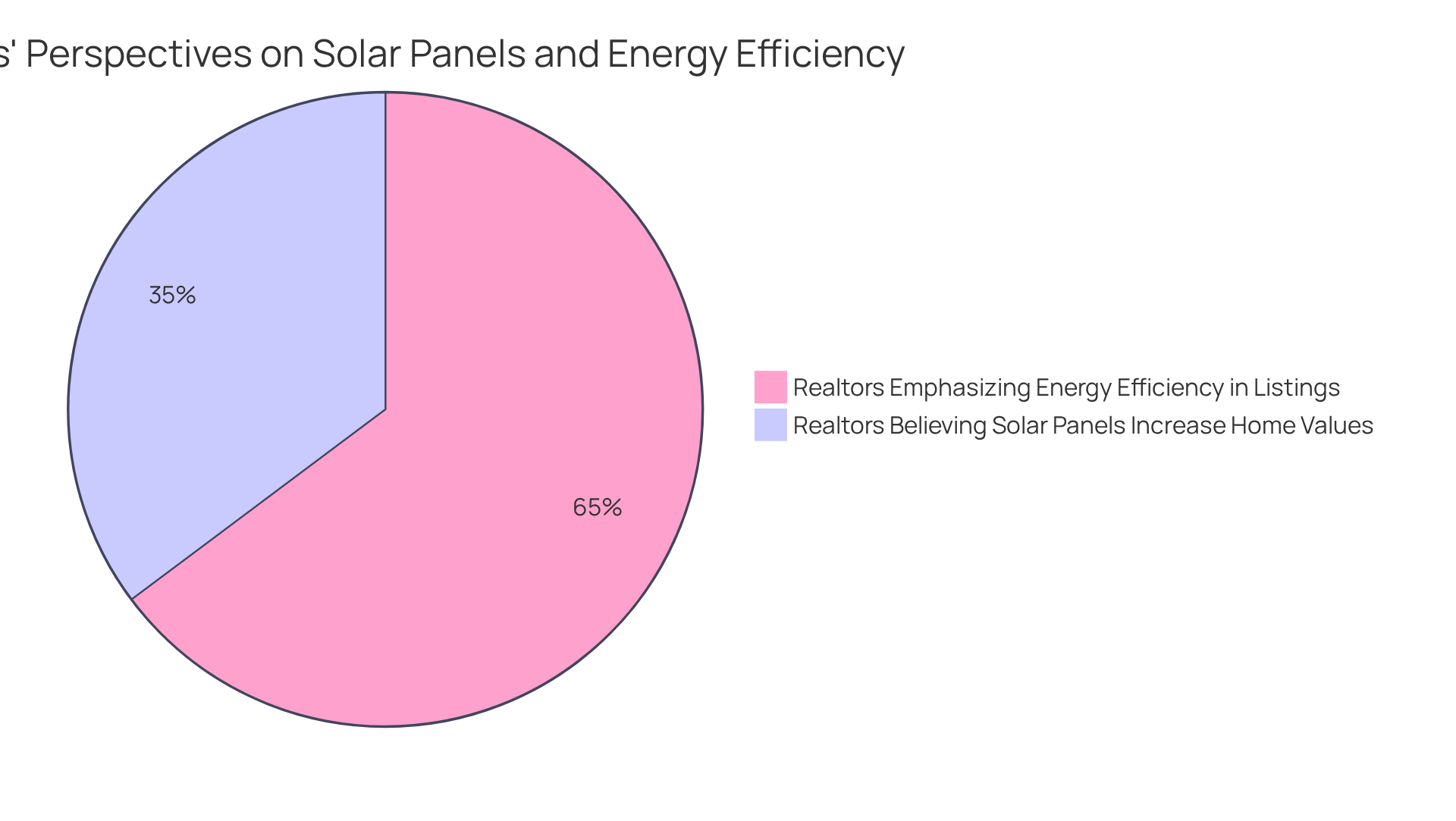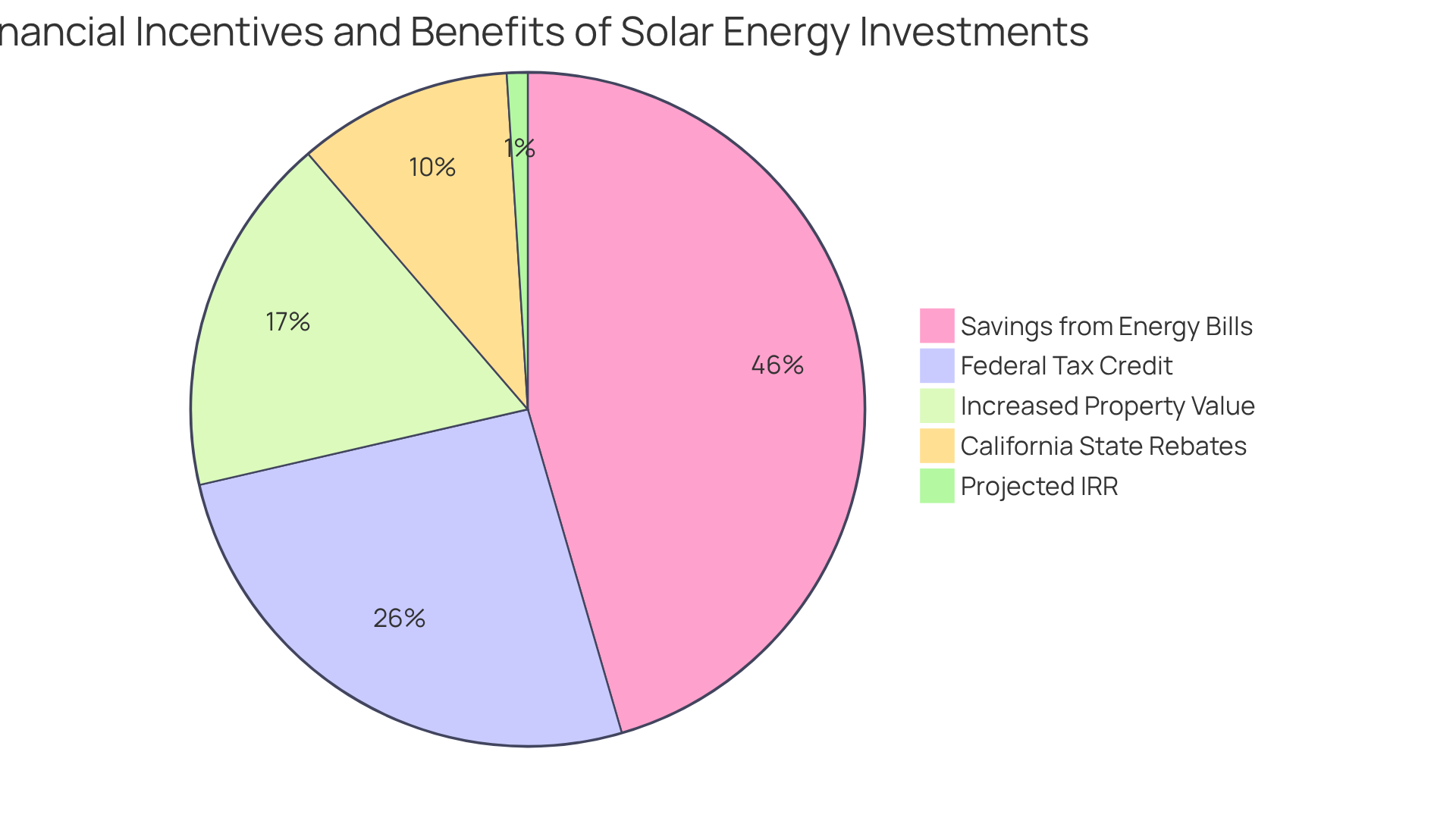Overview
We understand that rising energy bills can be a significant concern for many homeowners. That’s why we want to share with you seven key benefits of using a power inverter with solar panel systems. These advantages not only enhance energy efficiency but also lead to cost reductions, ensure reliability during outages, promote sustainability, and offer versatility. Additionally, they represent innovation and can even increase your property value.
Power inverters play a crucial role in optimizing energy conversion, enabling energy independence, and providing financial incentives. This makes solar energy a practical and sustainable choice for those of us looking to make a positive impact on our environment and our wallets.
Together, we can explore how these benefits can transform your energy habits and contribute to a more sustainable future. Have you considered how energy independence could reduce your stress about monthly bills? Let’s work towards making solar energy a reality for your home, providing you with the support and guidance you need every step of the way.
Introduction
As more homeowners seek relief from rising energy bills, the growing interest in renewable energy solutions has led many to explore the advantages of integrating power inverters with solar panel systems. These innovative devices not only enhance energy efficiency but also offer significant cost savings, reliability during outages, and a path toward sustainability.
We understand that the benefits of solar technology can feel overwhelming, and questions naturally arise:
- How can these systems truly transform energy consumption?
- What specific advantages do power inverters bring to the table?
This article delves into seven compelling benefits of using power inverters with solar panels, revealing how they can empower homeowners to achieve greater energy independence and contribute to a greener future. Together, we can navigate this journey towards a sustainable lifestyle.
Powercore Electric: Enhanced Energy Efficiency with Solar Inverters
We understand that can be a significant concern for homeowners. Powercore Electric addresses this by incorporating high-efficiency energy converters into its panel systems, which include a power inverter with solar panel to transform the direct current (DC) produced by photovoltaic panels into alternating current (AC) for home usage. This transformation is crucial for optimizing power generation, allowing you to harness the full capacity of your photovoltaic systems. By utilizing sophisticated converter technology, Powercore Electric not only improves the overall effectiveness of solar setups but also empowers you to save more on your utility bills while decreasing dependence on the grid.
In addition to enhancing power generation, contemporary devices play a vital role in stabilizing the grid. They manage frequency and voltage during peak demand periods, ensuring reliability when you need it most. For instance, installations fitted with intelligent devices can dynamically adjust operations based on environmental factors, guaranteeing optimal performance even in shaded areas. This flexibility not only optimizes power output but also contributes to grid stability, reassuring you that your energy needs are met.
Experts in the field emphasize the significance of high-efficiency photovoltaic converters. As highlighted by industry professionals, these devices are evolving into smart systems that enhance power generation and ensure seamless integration with renewable sources. The impact of photovoltaic converters on power generation is remarkable, with innovations leading to efficiency ratings that surpass 99%, significantly reducing power losses during transformation.
In summary, the incorporation of a power inverter with solar panel systems not only enhances efficiency but also plays a crucial role in our collective shift towards sustainable practices. Powercore Electric’s commitment to community service and transparency further reinforces its dedication to providing effective energy solutions for residents like you, who are eager to lower expenses and minimize environmental impact. Together, we can create a brighter, more sustainable future. If you’re ready to explore how solar energy can benefit you, let’s connect and discuss your options.
Cost Reduction: Lower Electricity Bills with Solar Inverters
We understand that managing electricity expenses can be a significant concern for many homeowners. Solar devices play a vital role in alleviating these worries by improving the efficiency of solar panels. By harnessing more sunlight and converting it into usable energy, families can see a remarkable reduction in their monthly utility bills. For instance, high-efficiency inverters boast conversion rates of up to 97%, which means that very little power goes to waste. This enhanced efficiency translates into considerable savings over time, making renewable energy a practical and financially sound choice for countless households.
Imagine saving an average of $1,500 each year through photovoltaic installations. This statistic not only highlights the financial benefits of transitioning to renewable energy but also emphasizes the potential for a more sustainable future. Considering that the average U.S. household spends around $1,834 annually on electricity, the savings from high-efficiency solar devices can lead to significant reductions in overall energy costs. Together, we can explore how these investments can enhance your energy independence and contribute to a greener planet.
It’s common to feel overwhelmed by the choices available, but remember that you are not alone in this journey. Let’s work towards a future where your energy expenses are manageable, and your home is powered by the sun. Your decision to not only benefits your wallet but also supports a healthier environment for all.
Reliability: Ensure Continuous Power Supply During Outages
Many homeowners share concerns about rising energy bills and the reliability of their power supply, prompting them to consider a power inverter with solar panel. One of the notable benefits of photovoltaic devices is their ability to provide a reliable power source during outages. Hybrid inverters, in particular, are designed to automatically switch to battery power when the grid fails, ensuring that essential appliances remain functional. This feature not only enhances autonomy in power supply but also offers , knowing you can rely on your system during emergencies.
We understand that energy independence is a priority for many, especially in areas vulnerable to outages. Proponents of self-sufficiency in power stress that technology such as a power inverter with solar panel is essential for ensuring a stable supply. Real-life instances illustrate how hybrid energy systems, which utilize a power inverter with solar panel, have successfully delivered uninterrupted power during critical situations, highlighting their efficiency in improving home resilience against power interruptions.
Moreover, hybrid power converters can notably lower expenses by enabling homeowners to use stored power during peak pricing times, making them a financially wise option. It’s common to feel apprehensive about the initial investment and the need for proper installation to maximize efficiency. However, together we can navigate these challenges and work towards a more sustainable future. If you’re ready to explore how these solutions can benefit you, let’s connect and discuss your options.
Sustainability: Reduce Carbon Footprint with Solar Energy
We understand that energy bills can be a significant concern for homeowners. Solar converters provide a compassionate solution by enabling the use of clean, renewable power when paired with a power inverter with solar panel. By transforming sunlight into usable electricity, the power inverter with solar panel not only helps reduce dependency on fossil fuels but also plays a vital role in lowering greenhouse gas emissions. Imagine how much you could save on utility expenses while making a meaningful contribution to the fight against climate change. Together, we can foster a healthier planet for future generations.
Investing in a power inverter with solar panel is not just about financial savings; it’s about gaining energy independence. Many homeowners have discovered that by utilizing a power inverter with solar panel to harness the power of the sun, they can take control of their energy needs and reduce their reliance on traditional energy sources. It’s common to feel overwhelmed by the options available, but remember, you are not alone in this journey.
Let’s work towards a sustainable future together. If you’re ready to explore how solar energy can benefit you and your family, we’re here to provide support and guidance every step of the way. Your decision to is a step towards a brighter, more sustainable future for all.
Versatility: Adaptable Solutions for Diverse Energy Needs
We understand that many homeowners are concerned about rising energy bills and the impact they have on their budgets. Solar devices are thoughtfully designed to be adaptable, catering to a wide range of power needs. Whether you’re looking for a compact system to address basic power requirements or a larger setup for , there are options available that can meet your specific necessities. This flexibility allows you to optimize your energy systems based on your unique circumstances, making renewable energy more accessible to everyone.
Together, we can explore how solar energy not only alleviates financial stress but also empowers you towards energy independence. Let’s work towards a sustainable future where you feel supported every step of the way.
Innovation: Leverage Advanced Technology in Solar Inverters
We understand that can be a source of stress for many homeowners. Contemporary photovoltaic converters, when used as a power inverter with solar panel, can significantly enhance your power efficiency and alleviate some of those concerns. One standout feature is Maximum Power Point Tracking (MPPT), which allows inverters to continuously adjust to changing sunlight conditions throughout the day. This capability ensures that your photovoltaic system can maximize power production, enabling your panels to perform at their best—even during low-light situations like overcast days or early mornings. In fact, MPPT technology can boost system efficiency by as much as 30%, making it a vital component for maximizing your energy output.
Moreover, intelligent photovoltaic converters facilitate communication with the grid, providing real-time information that empowers you to track your power consumption effectively. These devices can manage multiple arrays of photovoltaic modules with varying orientations or shading patterns, optimizing each panel’s output individually. This feature not only enhances the overall effectiveness of your solar system but also enables you to make informed decisions about your energy usage. As more homeowners strive to lower their energy expenses and achieve greater energy independence, incorporating a power inverter with solar panel into solar devices is essential for embracing sustainable energy solutions. Together, we can work towards a brighter, more energy-efficient future.
Convenience: Simplified Installation and Maintenance Processes
We understand that many homeowners are concerned about . Solar devices are designed with your convenience in mind, simplifying both installation and maintenance. Many modern devices feature user-friendly interfaces and comprehensive installation manuals, which significantly reduce setup times. Maintenance is minimal, typically requiring only periodic inspections to ensure optimal performance. This simplicity alleviates concerns about complex procedures and encourages more homeowners to embrace renewable energy solutions.
For instance, split-phase power converters, known for their compact design and compatibility with rooftop systems, are excellent user-friendly options that enhance efficiency while minimizing hassle.
As Ken Salazar noted, investing in photovoltaic power is a cost-effective way to move towards energy independence, and the ease of these devices plays a crucial role in that transition. Together, we can explore how these solutions can benefit you and your home.
Energy Independence: Generate and Store Your Own Power
Are you feeling the pinch of rising energy bills? Incorporating a power inverter with solar panel and battery storage systems can enable you to achieve remarkable autonomy in your power supply. This combination of a power inverter with solar panel enables you to produce and store your own energy, significantly reducing your reliance on the grid and easing the burden of escalating utility costs. Imagine having the ability to draw on stored energy during peak times or outages, ensuring a steady and reliable power supply for your home.
Currently, around 3.4% of electricity generated in the U.S. comes from sunlight, a figure that has steadily increased from 2.8% in 2021. This trend reflects a growing movement among homeowners toward renewable energy solutions. In fact, solar’s share of total U.S. electrical generation has skyrocketed from a mere 0.1% in 2010 to over 7% today, highlighting the significant adoption of solar technology over the years. This newfound independence not only enhances your personal resource security but also contributes to a more sustainable energy future for all.
Modern battery systems can keep essential appliances running for 12 to 24 hours on a single charge, offering peace of mind, especially in areas prone to power disruptions. The financial benefits are equally impressive; by utilizing stored energy during peak rates, homeowners can save significantly on utility bills. Smart management systems typically lower electricity expenses by 20-30%. Additionally, many utility providers offer incentives for homes that incorporate a power inverter with solar panel and storage systems, making the transition toward energy self-sufficiency a vital step for achieving a cleaner, more resilient energy landscape.
Together, we can embrace this opportunity for and sustainability. If you’re ready to explore how solar solutions can benefit you, let’s connect and work towards a brighter, more sustainable future.
Property Value: Boost Home Resale Value with Solar Installations
We understand that many homeowners are concerned about rising energy bills. Investing in renewable power systems, such as photovoltaic panels, can not only alleviate these concerns but also significantly increase your home’s resale value. Research indicates that homes equipped with photovoltaic panels sell for approximately 6.9% more than their non-photovoltaic counterparts, translating to an additional $29,000 for a median-priced home. This increase in property value stems from the and the growing demand for sustainable living solutions.
Moreover, it’s heartening to know that:
- 31% of realtors believe photovoltaic panels positively influence home values, reflecting a nurturing trend in the real estate market.
- 57% of real estate agents consider emphasizing a home’s energy efficiency, including renewable energy installations, to be beneficial in listings.
Homeowners can anticipate enhanced marketability and quicker sales. As Brett Johnson points out, many homebuyers are actively seeking properties with renewable energy systems, showing a collective shift towards sustainability.
Furthermore, Don Wede highlights that homes with photovoltaic panels are viewed favorably in the real estate market. However, it’s common to feel concerned about potential increases in property taxes due to the added value of these installations. Overall, photovoltaic installations represent a strategic investment for your future. Together, we can explore how these solutions can benefit you and your home while fostering a more sustainable community.
Incentives: Take Advantage of Tax Credits and Rebates for Solar Systems
As a homeowner, you may be concerned about rising energy bills and the impact they have on your budget. Fortunately, there are ways to significantly reduce your initial investment in renewable power systems through various tax incentives and refunds. The federal tax credit for renewable energy allows you to subtract a substantial portion of your installation expenses from your federal taxes, making renewable power more accessible than ever. In California, additional state-specific incentives, such as rebates and performance-based rewards, further enhance the financial viability of investing in renewable energy. For example, homeowners can benefit from programs that offer direct rebates based on the capacity of the energy system installed, leading to significant savings over time.
Consider the Dimmitt Chevrolet Solar Project, which successfully implemented renewable power solutions with a capacity of 730 kW. This project has not only lowered utility costs but also improved sustainability. By taking advantage of these incentives, homeowners can optimize their savings. In fact, forecasts suggest that a well-planned energy system could yield approximately $579,000 in electric bill savings over 25 years. Additionally, the rise in property value from photovoltaic systems can reach up to $480,000 at a 4% cap rate, showcasing the long-term financial benefits of transitioning to renewable energy. The projected (IRR) for such installations stands at around 14.4%, making it an appealing investment for eco-conscious homeowners. Another inspiring example is the CubeSmart managed property, which illustrates how solar installations can enhance property value by reducing operating costs.
We understand that making the switch to renewable energy can feel daunting, but together we can explore these options and find the best path forward for your home. Let’s work towards a more sustainable future, ensuring not only savings but also a positive impact on our environment.
Conclusion
We understand that managing energy bills can be a significant concern for many homeowners. Incorporating a power inverter with solar panel systems offers a transformative approach to energy consumption, enabling you to maximize efficiency, reduce costs, and promote sustainability. By converting direct current (DC) from solar panels into usable alternating current (AC), these inverters enhance overall power generation, ensuring that you can utilize renewable energy effectively while minimizing reliance on traditional power grids.
Imagine the relief of seeing significant reductions in your electricity bills, enhanced reliability during outages, and the satisfaction of contributing to a more sustainable environment. Innovations in solar inverter technology, such as Maximum Power Point Tracking (MPPT), improve energy efficiency, allowing you to harness the full potential of your solar systems. The versatility of these devices ensures that they can cater to various energy needs, making solar energy accessible to a wider audience.
Ultimately, embracing solar energy solutions, particularly through the use of power inverters, is not just a practical financial decision but a crucial step towards a sustainable future. We encourage you to explore the available incentives and benefits that come with investing in renewable energy systems. By taking action today, you can contribute to a cleaner environment while enjoying the long-term advantages of energy independence and financial savings. Together, let’s engage with solar technology as a pathway to enhance your well-being and foster a healthier planet for generations to come.
